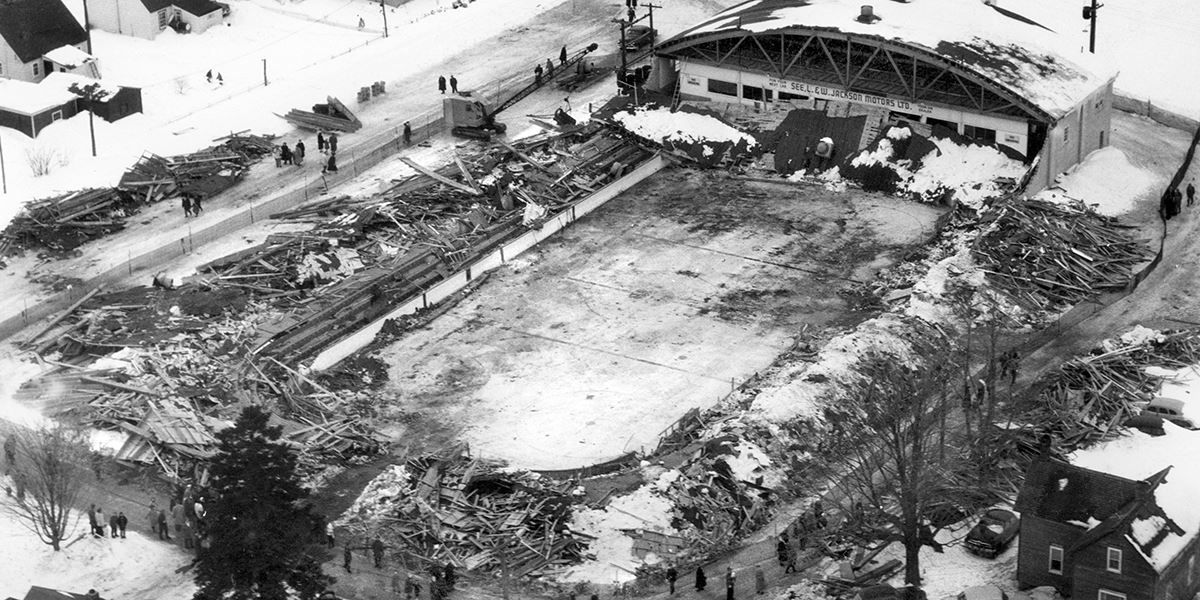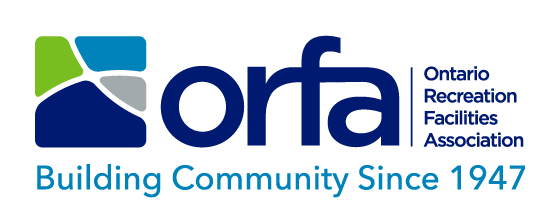FACILITY ALERT
Impact of Roof Snow Load Weight Calculations Towards Facility Structural Failure
Version 2.0 Issue Date: January 2022

Listowell Arena Collapse, 1959 Killing 8 People
Introduction
The Ontario Recreation Facilities Association Inc. (ORFA) continues to raise awareness and concern over Ontario’s aging recreation facility infrastructure; the lack of comprehensive professional structural engineer reviews of these facilities and; the absence of regular ongoing inspection for increased stress and strain caused by excessive snow load by building staff. These factors are challenging the structural integrity of many recreation facilities.
Shifting Weather Patterns
All recreation facilities are designed to withstand snow and ice loads based on the specific region they are constructed in. Other factors that are taken into consideration include wind and dead load. Dead loads include the weight of the roofing materials and structure. The shifting and unpredictable weather patterns when combined with aging infrastructure will require increased monitoring to ensure the facility remains safe and serviceable. If possible, original blueprint construction documents should be reviewed to confirm original design and construction meet current conditions.
What is Structural integrity?
Structural integrity is the original engineering of a building that deals with the ability to support a designed weight or force (load) without breaking, tearing apart, or collapsing during reasonable use for the building life expectancy. When weights and/or loads exceed these designed limits, they cause structural failure. Structural failure refers to the loss of structural integrity. Owners of buildings must ensure that both workers and users remain safe while in attendance. The presence of snow and ice on any roof will exert loads that can cause the system to sag or bow downward. This loading will also transfer horizontal forces that may cause the walls to deflect or move slightly outward at the top or bottom of the wall. This impact will only be seen when the load is present and will often disappear when the load is removed However, consistent loads will cause the roof system to weaken and possibly permanently sag. Workers are given the right to a safe work environment under the Occupational Health and Safety Act (OHSA).
Duties of Employers
25. (1) An employer shall ensure that, (e) a building, structure, or any part thereof, or any other part of a workplace, whether temporary or permanent, is capable of supporting any loads that may be applied to it, (i) as determined by the applicable design requirements established under the version of the Building Code that was in force at the time of its construction, (ii) in accordance with such other requirements as may be prescribed, or (iii) in accordance with good engineering practice, if sub- clauses (i) and (ii) do not apply. R.S.O. 1990, c. O.1, s. 25 (1); 2011, c. 11, s. 9.
Duties of the Joint Health and Safety Committee (JHSC)
9. Inspections
(23) Subject to subsection (24), the members of a committee who represent workers shall designate a member representing workers to inspect the physical condition of the workplace. R.S.O. 1990,
c. O.1, s. 9 (23).
(26) Unless otherwise required by the regulations or by an order by an inspector, a member designated under subsection (23) shall inspect the physical condition of the workplace at least once a month. R.S.O. 1990, c. O.1, s. 9 (26).
Schedule of Inspections
(28) The inspection required by subsection (27) shall be undertaken in accordance with a schedule established by the committee. R.S.O. 1990, c. O.1, s. 9 (28).
(30) The member shall inform the committee of situations that may be a source of danger or hazard to workers and the committee shall consider such information within a reasonable period of time. R.S.O. 1990, c. O.1, s. 9 (30).
Occupational Health and Safety Act, R.S.O. 1990, c. O.1
Users of any public building are given the same expectation of safety under the Occupiers Liability Act.
Occupier’s Duty
3. (1) An occupier of premises owes a duty to take such care as in all the circumstances of the case is reasonable to see that persons entering on the premises, and the property brought on the premises by those persons are reasonably safe while on the premises.
(2) The duty of care provided for in subsection (1) applies whether the danger is caused by the condition of the premises or by an activity carried on the premises.
Occupier’s Liability
Occupiers' Liability Act, R.S.O. 1990, c. O.2
Governing Authorities
The owner is responsible to know and adhere to all applicable legislation. The Ontario Ministry of Labour Training and Skills Development (MOLTSD) is responsible for compliance of the OHSA. The Ministry of Labour Training and Skills Development (MOLTSD) no longer releases reminders to owners of such obligations (MOL Bulletin of Apr.4/97); it is therefore an owner’s responsibility to have structural inspections performed on an as required basis by a professional structural engineer. Breaches of the Occupiers Liability Act must be dealt with through the civil court. Unless there is a death, then the local police jurisdiction may further play a role in investigating the incident as it may be deemed to be criminal in nature. An additional internal resource to be considered is local building officials as they are highly trained in such matters and will lend both guidance and support in maintaining a safe environment for both workers and the public at large.
The worker is responsible under the Internal Responsible System (IRS) of the OHSA to further play a role in ensuring workplace safety. This would include, but not be limited to, monitoring and continually reporting changes to the structure. As individuals who are regularly moving throughout the building, workers must be trained to understand the importance of continually looking for signs of twisting, shifting, lifting, bending, or cracking. These changes may be caused from loading on the roof or shifting soils due to ground freezing. Buildings that are experiencing continual water penetration are at higher risk as rust may significantly contribute to the loss of structural integrity. Such discoveries must be reported to senior facility staff and/or the JHSC.
Excessive Snow Loading
The most common contributing factor to structural failure is excessive snow loading, which is defined as, “the live load due to the weight of snow on a roof; included in the original design calculations”. When a worker views what might be considered excessive snow on the roof from the ground, it is important that a further site review be undertaken. It is often difficult to visually determine the potential risk of snow load. The actual risk of the snow load is weight not depth. Weight is based on water content that can range from 3-33% for “dry snow” and 33% to 100% for wet snow to ice. An inch of water depth weighs 5.2lbs per square foot. A roof designed to carry a snow load of 20lbs is designed to hold 12-inches of wet snow. Should a facility manager wish to calculate snow weight, the following process may provide some information that can assist in the decision-making process.
Step 1: collect a uniform vertical column of snow from the roof. A typical 6-inch coffee can be used. Thrust the can vertically into the snow until filled. Dump the collected snow in a larger pail. Continue until the can hits the top of the roof.
Step 2: Allow the snow in the collection pail to melt to a water state. S
tep 3: Once melted, dump the water back into the coffee can used to collect the snow and measure the actual water depth. For example, if there is 4-inches of water in the can the roof has approximately 21lbs per square foot (4 x 5.2=20.8). Although not 100% accurate the test will at best provide some direction toward the level of risk.
Only persons trained to safely work at heights should consider going up onto any roof above 3m (10ft). If there is a reasonable concern of excessive snow loading the benefits of retaining the services of a civil or structural engineer should be considered to:
- determine whether snow loads are excessive;
- determine whether there are signs of structural distress;
- to obtain a removal procedure that will not cause more structural problems;
- reinforce a structure that is overstressed.
Once complete it then becomes the owners responsibility to implement safe snow removal procedures. Workers must be adequately trained for the snow removal task. Training should include, but not be limited to:
- Safely getting up and down from the roof (people and equipment)
- Fall restraint and tie off obligations (workers on a roof must use fall-arrest or travel- restraint equipment in accordance with the fall protection requirements of the Regulations for Industrial Establishments - RRO 851, s. 85).
- The dangers of producing uneven or concentrated snow loading
- Securing the area where snow is to be dumped onto the ground
- Proper shoveling techniques
- Working safely outdoors in cold conditions
Facility managers must also consider the potential for roof damage if excessive snow load is to be removed. Considering the expertise of construction professionals may be a good long-term investment.
Conclusion
As Ontario’s recreation facilities age and owners are continually pressured to be fiscally responsible, items such as structural engineer inspections may be considered less of a priority and can be placed on hold for more pressing matters. For those who work in such an environment, it is important that each person professionally engage in their right for a safe work environment. Be informed, interact with senior facility staff and the JHSC and continually monitor your work environment to ensure safe conditions are being maintained.
Related Resources
- Snow Load Calculation, National Research Council Canada
- Two Durham soccer domes collapse during blizzard, Oshawa This Week, January 18, 2022
- Snow Load & Facility Structural Integrity Failures, Facility Forum, Volume 21, Issue 1
- Alert: Snow loading and roof failures, Ministry of Labour, Training and Skills Development
- Alert: Falling Ice on Construction Projects, Ministry of Labour, Training and Skills Development
COPYRIGHT © 2022 ONTARIO RECREATION FACILITIES ASSOCIATION INC.
DISCLAIMER: While the Ontario Recreation Facilities Association Inc. (ORFA) does its best to provide useful general information and guidance on matters of interest to its members, statutes, regulations and the common law continually change and evolve, vary from jurisdiction to jurisdiction, and are subject to differing interpretations and opinions. The information provided by the ORFA is not intended to replace legal or other professional advice or services. The information provided by the ORFA herein is provided “as is” and without any warranty, either express or implied, as to its fitness, quality, accuracy, applicability or timeliness. Before taking any action, consult an appropriate professional and satisfy yourself about the fitness, accuracy, applicability or timeliness of any information or opinions contained herein. The ORFA assumes no liability whatsoever for any errors or omissions associated with the information provided herein and furthermore assumes no liability for any decision or action taken in reliance on the information contained in these materials or for any damages, losses, costs or expenses in any way connected to it. ORFA documents are made available as a benefit of membership and are always open for suggested edits, corrections and improvements. Further, all ORFA resources are restricted for use by members in good standing for awareness and education purposes only. We ask that ORFA resources not be uploaded to the internet.
ONTARIO RECREATION FACILITIES ASSOCIATION INC. • 1 CONCORDE GATE, SUITE 102, TORONTO, ON M3C 3N6 • 416.426.7106 • ORFA.COM • EMAIL US
